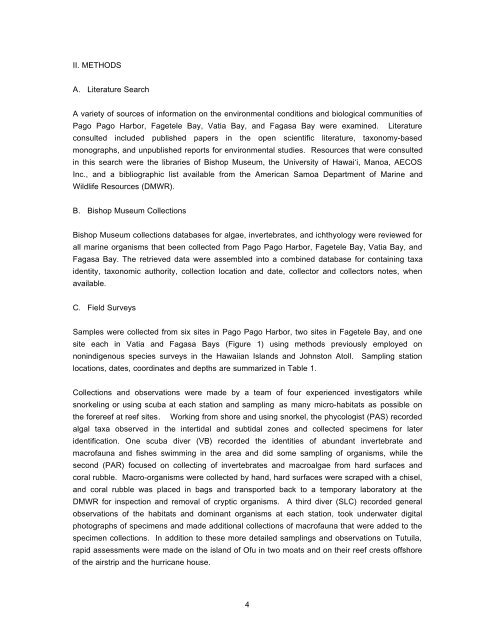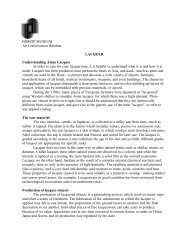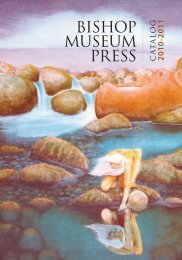INTRODUCED MARINE SPECIES IN PAGO ... - Bishop Museum
INTRODUCED MARINE SPECIES IN PAGO ... - Bishop Museum
INTRODUCED MARINE SPECIES IN PAGO ... - Bishop Museum
Create successful ePaper yourself
Turn your PDF publications into a flip-book with our unique Google optimized e-Paper software.
II. METHODS<br />
A. Literature Search<br />
A variety of sources of information on the environmental conditions and biological communities of<br />
Pago Pago Harbor, Fagetele Bay, Vatia Bay, and Fagasa Bay were examined. Literature<br />
consulted included published papers in the open scientific literature, taxonomy-based<br />
monographs, and unpublished reports for environmental studies. Resources that were consulted<br />
in this search were the libraries of <strong>Bishop</strong> <strong>Museum</strong>, the University of Hawai‘i, Manoa, AECOS<br />
Inc., and a bibliographic list available from the American Samoa Department of Marine and<br />
Wildlife Resources (DMWR).<br />
B. <strong>Bishop</strong> <strong>Museum</strong> Collections<br />
<strong>Bishop</strong> <strong>Museum</strong> collections databases for algae, invertebrates, and ichthyology were reviewed for<br />
all marine organisms that been collected from Pago Pago Harbor, Fagetele Bay, Vatia Bay, and<br />
Fagasa Bay. The retrieved data were assembled into a combined database for containing taxa<br />
identity, taxonomic authority, collection location and date, collector and collectors notes, when<br />
available.<br />
C. Field Surveys<br />
Samples were collected from six sites in Pago Pago Harbor, two sites in Fagetele Bay, and one<br />
site each in Vatia and Fagasa Bays (Figure 1) using methods previously employed on<br />
nonindigenous species surveys in the Hawaiian Islands and Johnston Atoll. Sampling station<br />
locations, dates, coordinates and depths are summarized in Table 1.<br />
Collections and observations were made by a team of four experienced investigators while<br />
snorkeling or using scuba at each station and sampling as many micro-habitats as possible on<br />
the forereef at reef sites. Working from shore and using snorkel, the phycologist (PAS) recorded<br />
algal taxa observed in the intertidal and subtidal zones and collected specimens for later<br />
identification. One scuba diver (VB) recorded the identities of abundant invertebrate and<br />
macrofauna and fishes swimming in the area and did some sampling of organisms, while the<br />
second (PAR) focused on collecting of invertebrates and macroalgae from hard surfaces and<br />
coral rubble. Macro-organisms were collected by hand, hard surfaces were scraped with a chisel,<br />
and coral rubble was placed in bags and transported back to a temporary laboratory at the<br />
DMWR for inspection and removal of cryptic organisms. A third diver (SLC) recorded general<br />
observations of the habitats and dominant organisms at each station, took underwater digital<br />
photographs of specimens and made additional collections of macrofauna that were added to the<br />
specimen collections. In addition to these more detailed samplings and observations on Tutuila,<br />
rapid assessments were made on the island of Ofu in two moats and on their reef crests offshore<br />
of the airstrip and the hurricane house.<br />
4






